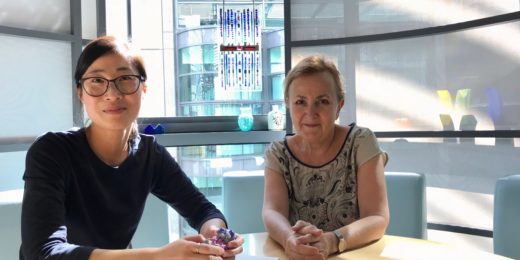Stanford pediatric hematology experts Mark Wilkes, PhD, and Kathleen Sakamoto, MD, PhD, recently identified a protein that they believe is an excellent drug target for a rare genetic disease. The disease, called Diamond Blackfan anemia, is an inherited condition that interferes with how red blood cells form.
When I called Wilkes to talk about the study, which just published in Nature Communications, I said I hoped this story would advance my top-secret agenda of convincing people that proteins are more interesting than genes.
He burst out laughing -- not the first time someone has laughed at how nerdy I am -- and agreed with my bias for proteins, which I love because they make up the cogs and wheels inside every cell.
"Genes are just the blueprint," said Wilkes. "The proteins do the work."
First step to less-burdensome treatment
The scientists wanted to learn about the cogs and wheels of this disease as the first step in developing less-burdensome treatments. In Diamond Blackfan anemia, patients' bodies make very few red blood cells. Throughout life, many patients need regular blood transfusions, which means frequent doctor or hospital visits, possible iron overload and associated organ damage. Patients also receive steroid medications, but these have several bad side effects, including impairing kids' growth and suppressing the immune system. The Stanford researchers want to find a drug that could stimulate red blood cell formation without the side effects of current therapies.
But it's tricky: Although Diamond Blackfan anemia is a genetic disease, not all patients have the same underlying gene mutation. In fact, researchers have identified 24 distinct mutations that can lead to the disease.
Instead of trying to address each of these genetic glitches individually, the Stanford team asked which malfunctioning cellular machinery patients have in common.
Enzymes that act like traffic lights
The malfunctioning protein they identified is an enzyme called Nemo-like kinase. Kinases are a family of enzymes that act like intracellular traffic lights.
In Diamond Blackfan anemia, this particular traffic light is overactive, almost always set to "green," which is very bad for overall traffic flow in the cell. But there's good news: Just as adjusting the settings on a traffic light is easier than installing speed bumps on the road, slowing down a kinase is a lot easier than fixing faulty genes.
Using human and mouse cells-in-a-dish models, the Stanford researchers showed that chemicals that turn down the enzyme's activity could reverse problems with red blood cell formation. Because the effects of the enzyme glitch are fairly specific to this process, the researchers think a drug to dampen the activity of Nemo-like kinase would have fewer side effects than current Diamond Blackfan anemia treatments.
Sakamoto and Wilkes are currently pursuing strategies to identify a new drug, including screening existing FDA-approved drugs that are known to change how other kinases work.
Gene therapy might eventually also become possible, but the scientists like the efficiency of finding a medication that helps all Diamond Blackfan anemia patients.
"I think of it as one-stop shopping," Sakamoto said. "Instead of doing a designer gene therapy for each patient, we can do one-stop shopping and treat many more patients."
Photo by Carlos Alberto Gomez Inguinez






